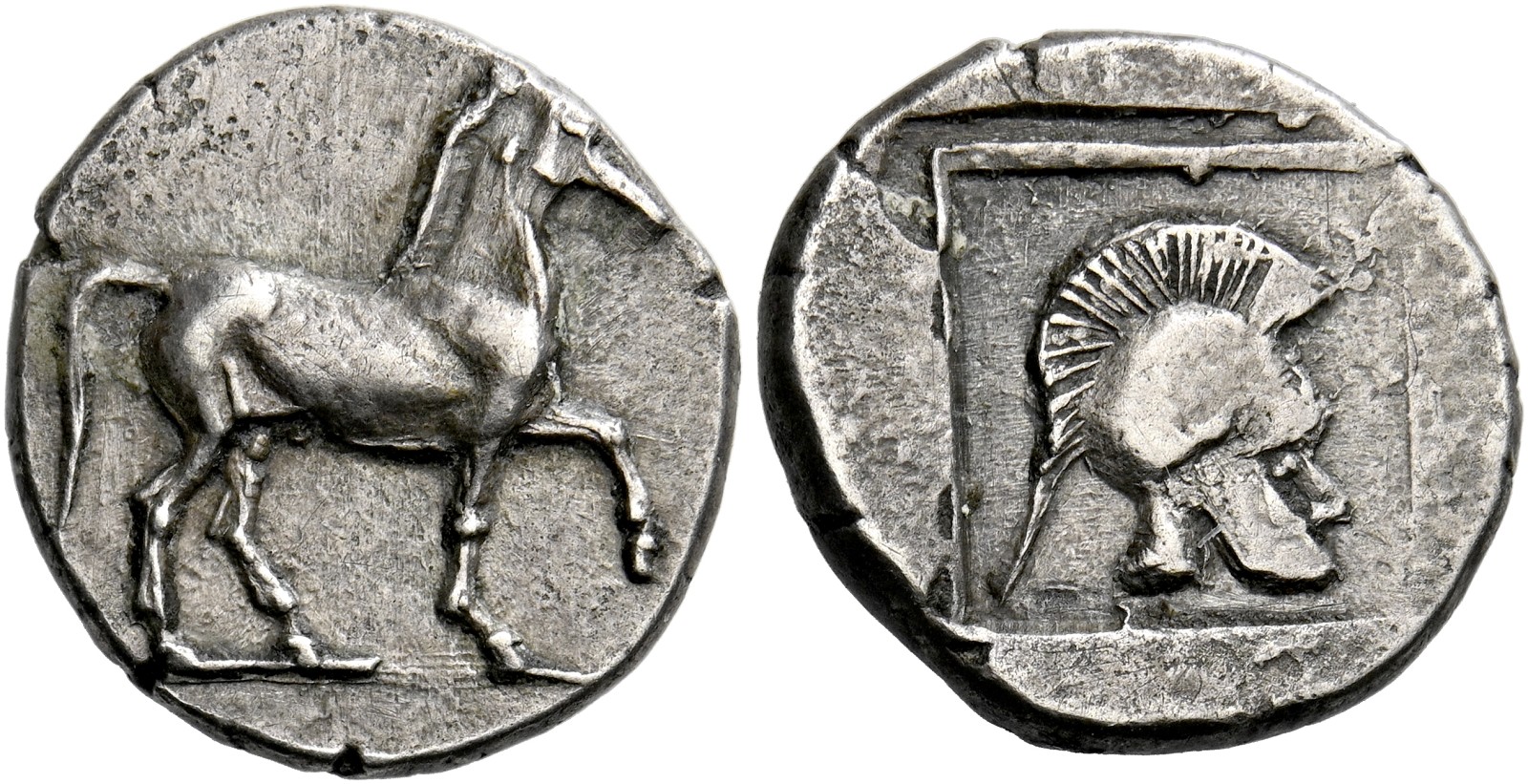AC 166 - Aigai (Alexander I), silver, light tetrobols (476-460 BCE)
From SILVER
476 BCE - 460 BCE Silver 3,759 kg
Description
| ObverseInscription or printing placed on the obverse.: | Horse at pace r. |
| ReverseInscription or printing placed on the reverse.: | Male head r., wearing crested Attic helmet, all within incuse square with linear border |
Mint and issuing power
| MintIdentifies the place of manufacture or issue of a numismatic object.: | Aigai | Ancient regionAncient region.: | Macedon | Modern countryModern country: Greece | AuthorityIdentifies the issuing power. The authority can be "pretended" when the name or the portrait of X is on the coin but he/she was not the issuing power. It can also be "uncertain" when there is no mention of X on the coin but he/she was the issuing power according to the historical sources: | Alexander I of Macedon (Argead king, c. 498-454 BC) |
Chronology
| FromIdentifies the initial date in a range assigned in a numismatic context. | 476 BCE | toIdentifies the final date in a range assigned in a numismatic context.. | 460 BCE | PeriodTime period of the numismatic object.: Classical 480-323 BC |
Physical description
| MetalThe physical material (usually metal) from which an object is made.: | Silver |
Median weightMedian of the weights of numismatic objects (in grams). in grams | 2.10 | DenominationTerm indicating the value of a numismatic object. Examples: tetradrachm, chalkous, denarius.: | tetrobol |
StandardStandard.: | Thraco-Macedonian |
Image

AC166 Alexander I tetrobols.jpg [1]
References
| Die study referencePublication of the study: | Raymond 19531Raymond 1953, n° 34-44, 76-107 and 122-30, Hersh 19912Hersh 1991, p. 9-11 | ||
| Coin series referenceReference to coin series study: | Sear I3Sear I, n° 1484, RQEMAC4RQEMAC, n° 166, HGC 3.15HGC 3.1, n° 773-774 | ||
| Coin series web referenceCoin series web references: | |||
Obverse dies distribution
| FrequencyFrequency of specimen in distribution. ᵖ | Number of obversesNumber of obverse dies. ᵖ (o) | % (o) | Number of coinsNumber of coins. (n) | % (n) | Die nameName(s) of the die(s). |
| 1 | 26 | 40.63 | 26 | 16.35 | 3, 8, 15, 18, 20, 24, 26, 28, 30, A, B, C, D, F, G, Q, R, S, U, V, Y, Z, AA, AB, AE, AG |
| 2 | 16 | 25 | 32 | 20.13 | 1, 12, 16, 22, 23, 25, 27, 34, E, I, L, N, P, T, X, AF |
| 3 | 9 | 14.06 | 27 | 16.98 | 2, 9, 11, 17, 29, H, J, K, W |
| 4 | 6 | 9.38 | 24 | 15.09 | 6, 19, 21, M, O, AD |
| 5 | 2 | 3.13 | 10 | 6.29 | 4, 13 |
| 6 | 1 | 1.56 | 6 | 3.77 | 7 |
| 7 | 1 | 1.56 | 7 | 4.4 | 5 |
| 9 | 3 | 4.69 | 27 | 16.98 | 10, 14, AC |
| Total | 64 of 64 | 100.01 | 159 of 159 | 99.99 |
Reverse dies distribution
no distribution is available
Quantification
| Number of obversesNumber of obverse dies. ᵖ (o) | 64 | Number of singletons (o1)The number of singleton coins. ᵖ | 26 |
| Number of reverse diesNumber of reverse dies. (r) | Number of coinsNumber of coins. (n) | 159 | |
| Coins per obverse dieNumber of coins per obverse die. (n/o) | 2.48 | Coins per reverse dieNumber of coins per reverse die. (n/r) | |
| Reverse per obverse ratioRatio of obverse dies divided by reverse dies. (r/o) | Percentage of singletons (o1)number of coins (n) divided by the number of singletons (o1) ᵖ | 40.63 % | |
| Original number of dies (O) (Carter 1983 formula)The estimation of the number of coins according to Carter 1983 ᵖ | 89.5 | Coins struck if 20,000 as average productivity per dieCoins made if the average productivity for obverses (according to Carter) is 20,000. ᵖ | 1,790,000 |
| Original number of dies (O) (Esty 2011 formula)The estimation of the number of coins according to the singleton formula in Esty 2011 ᵖ (O) | 107.12 | Survival rate if 20,000 as average productivity per dieSurvival rate if average productivity is 20,000. ᵖ | 0.00009 |
| Coverage (o = % of O) (Esty 1984 formula)Esty 1984 - coverage (% of O) ᵖ (o = % of O) | 83.65% | Die productivity if survival rate 1/2,000Average productivity if survival rate is 1/2,000. ᵖ | 3,553.07 |
| Weight of silver (in kg) if 20,000 coins per die (O = Carter formula)Carter 1983 * Median weight * 20000 (*10 if gold or electrum) ᵖ | 3,759 kg <br /> 3,759 kg | Die productivity if survival rate 1/5,000Average productivity if survival rate is 1/5,000. ᵖ | 8,882.68 |
Remarks
Most likely one single workstation This is the improved die study combining Raymond 1953 and Hersh 1991